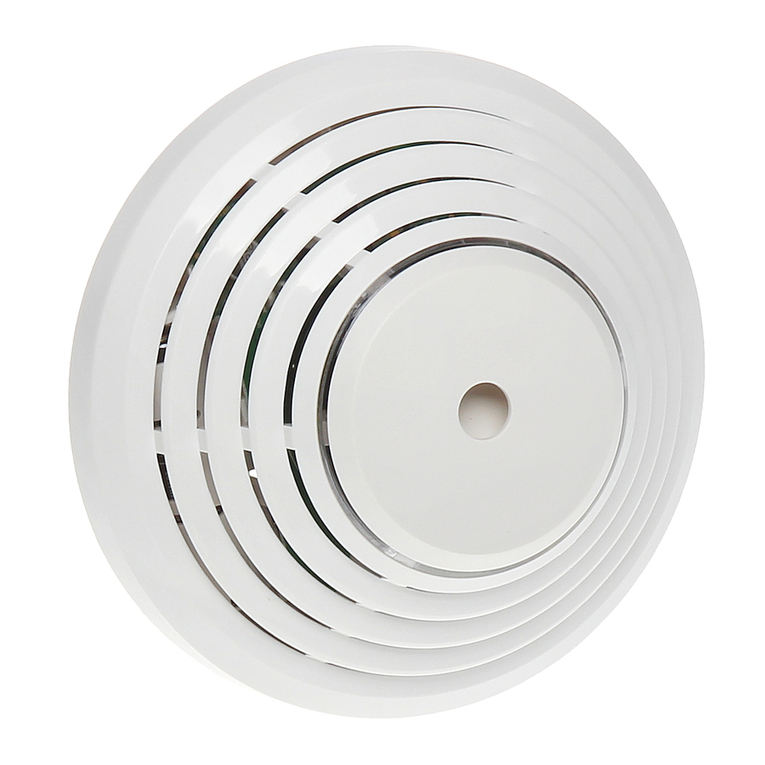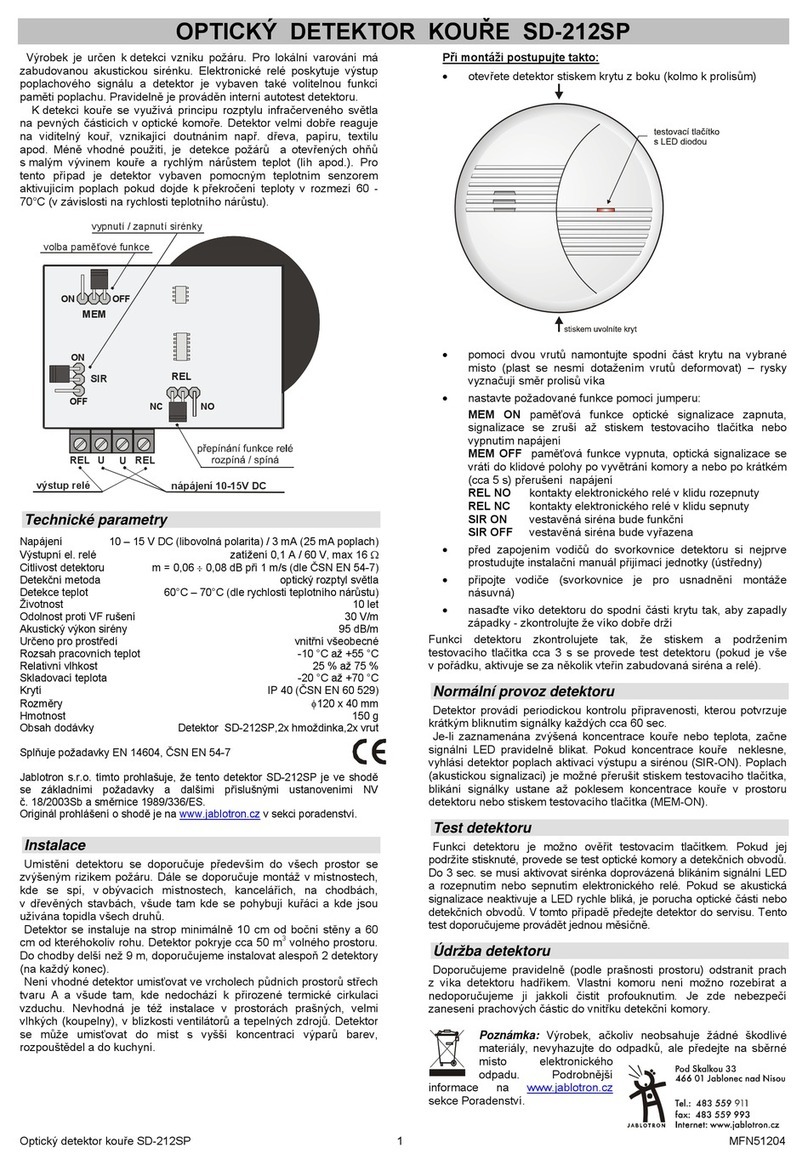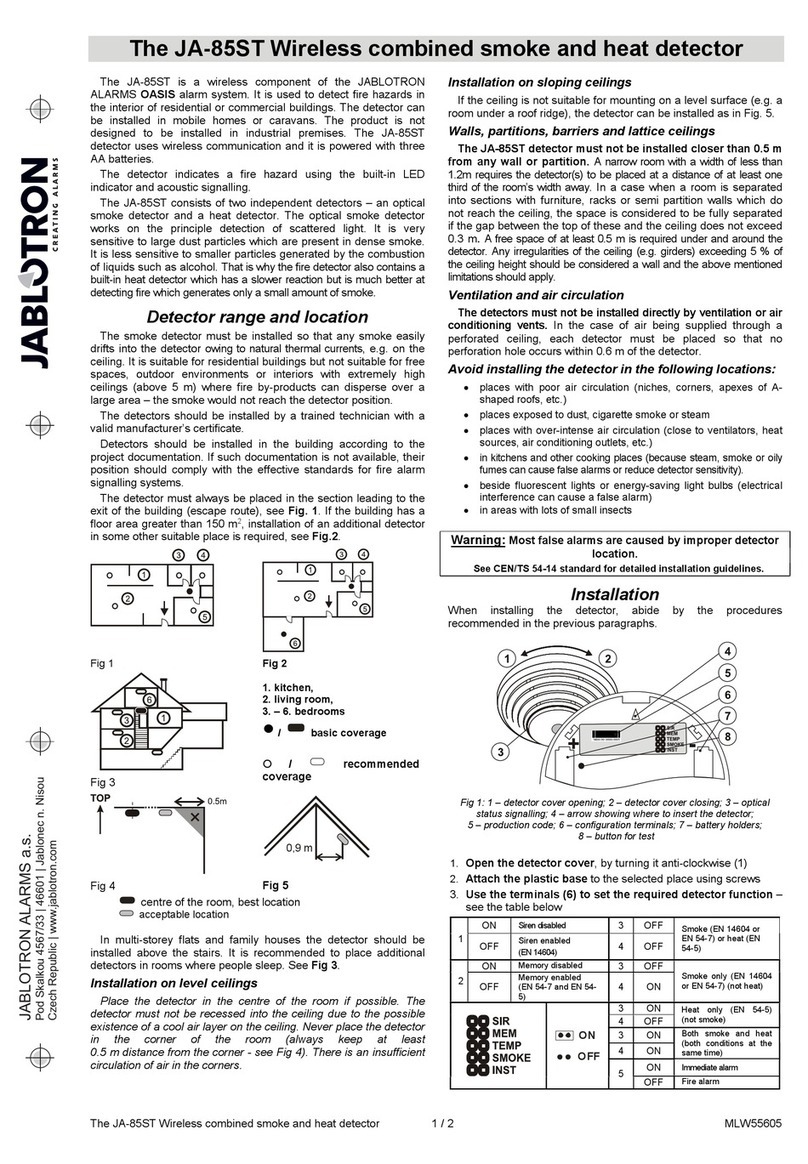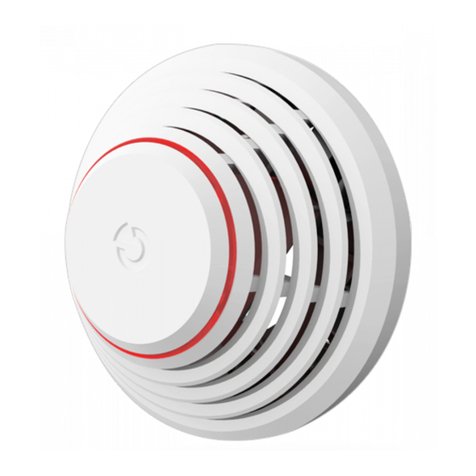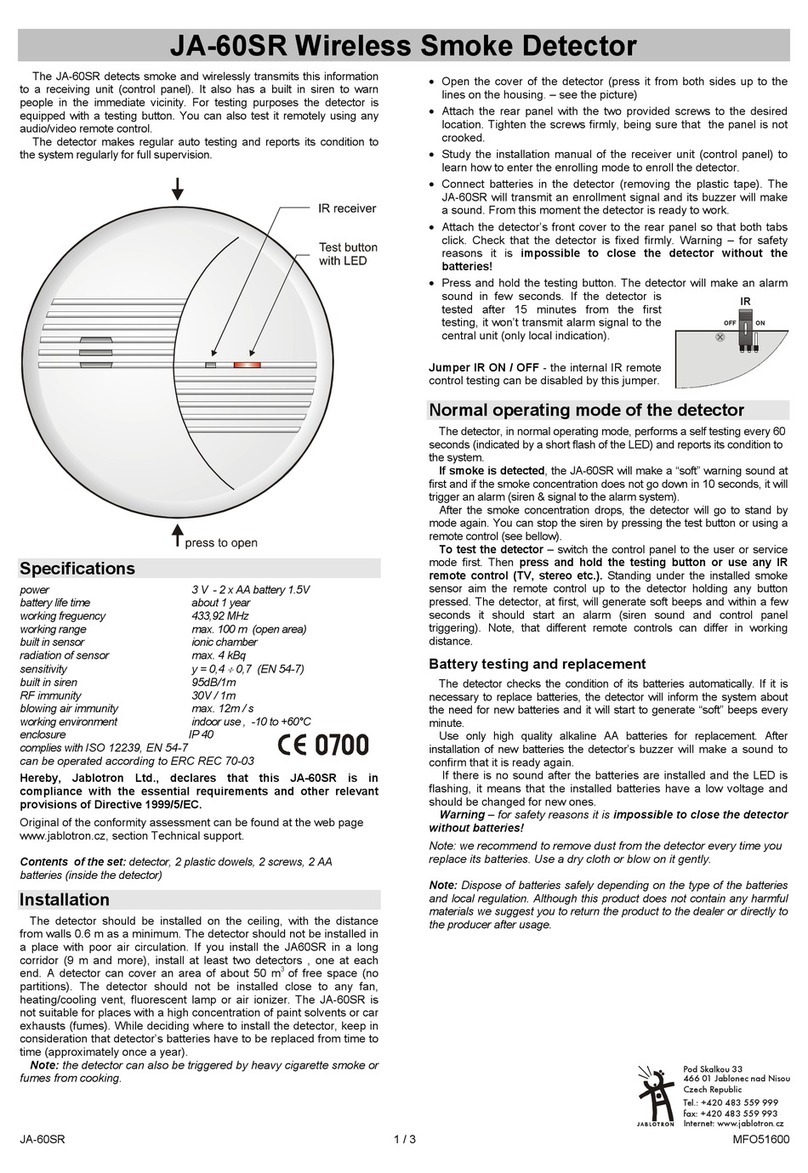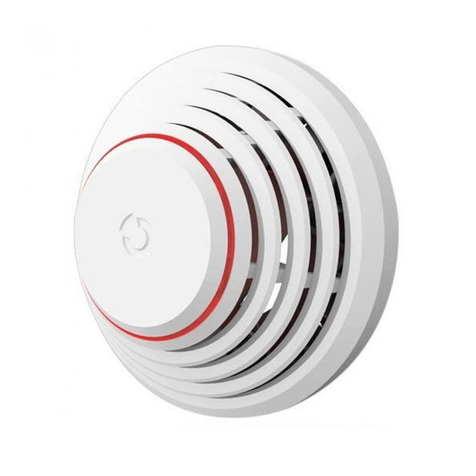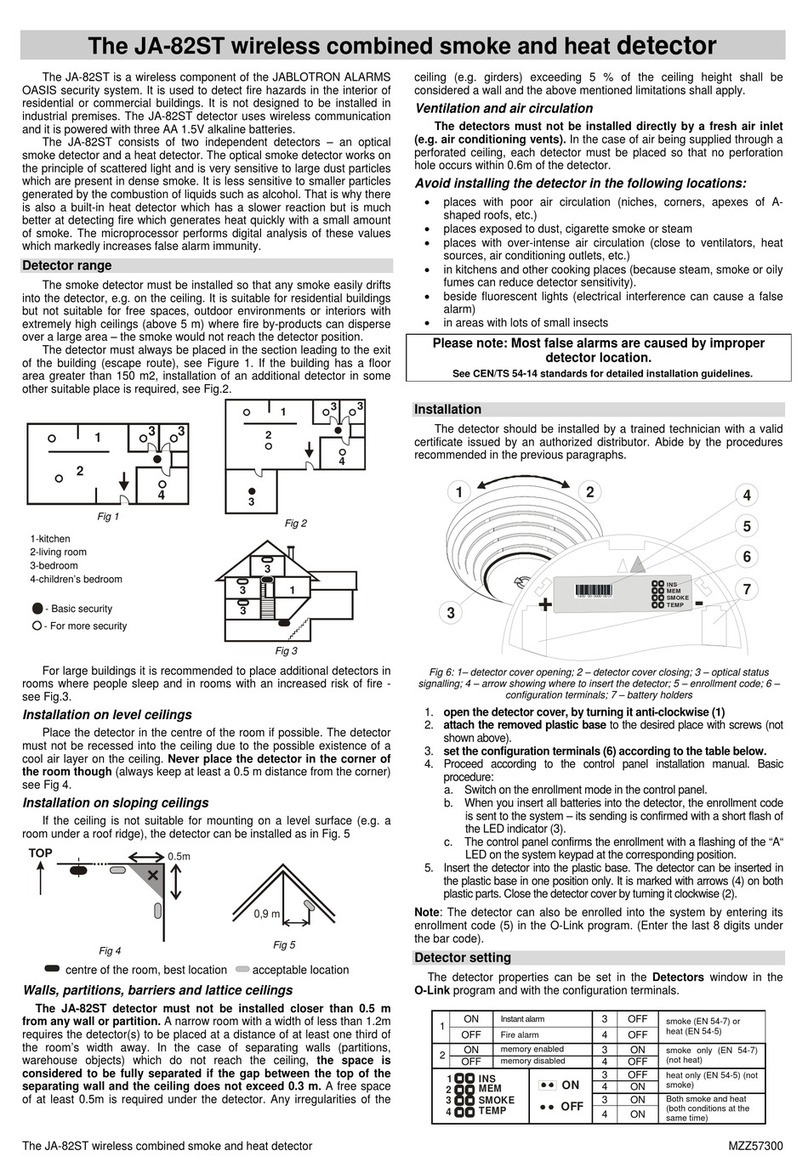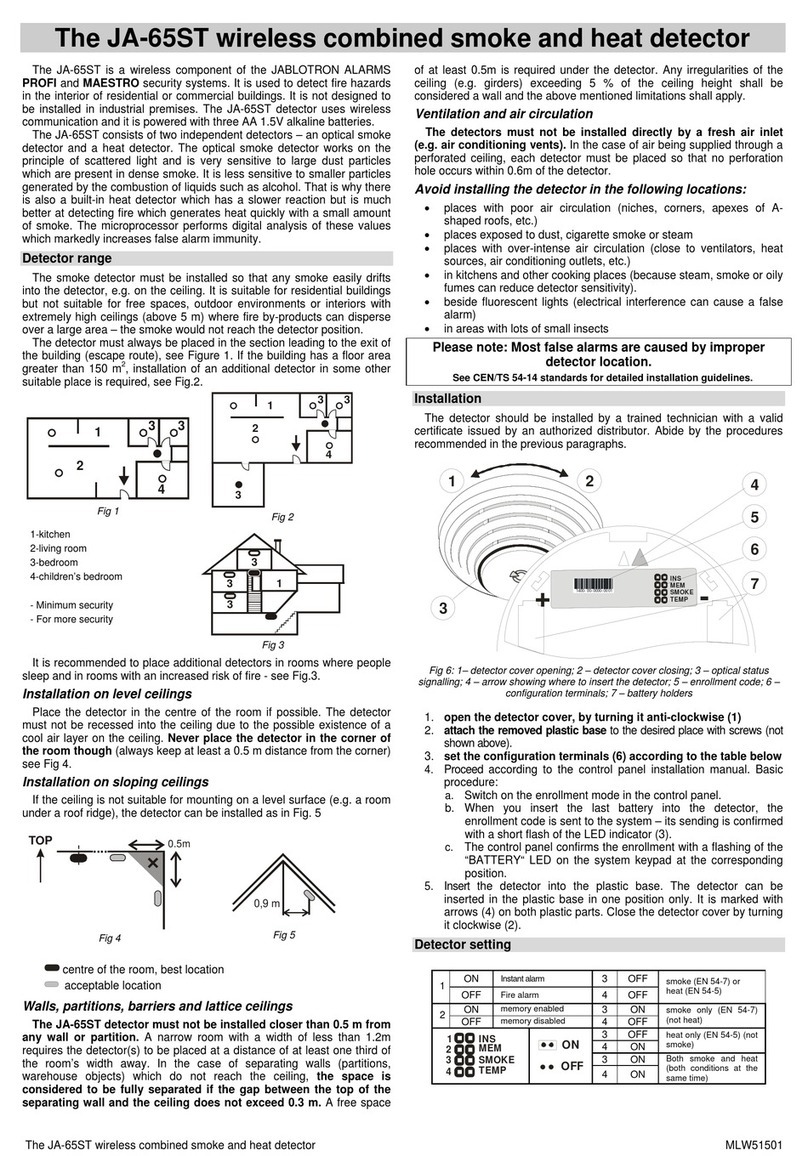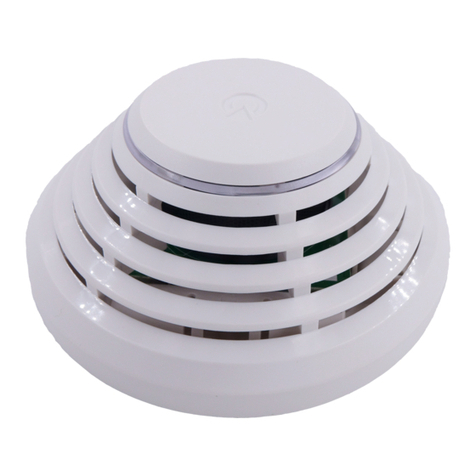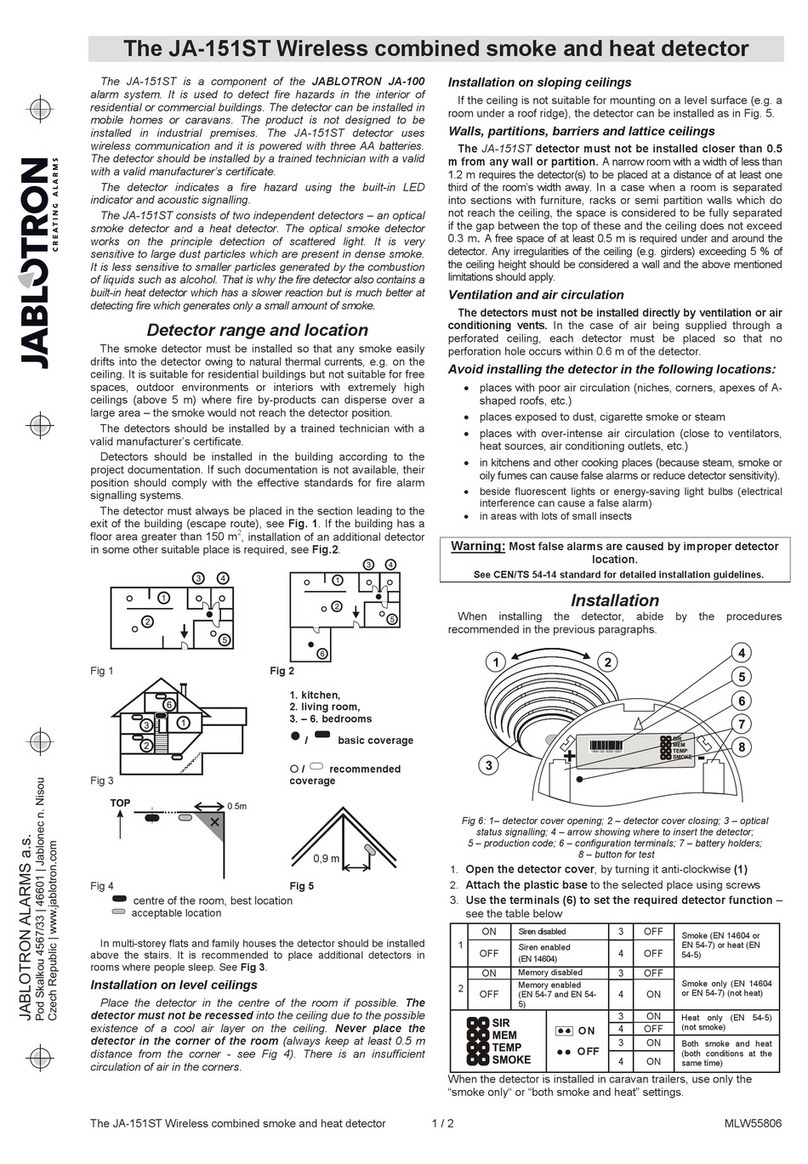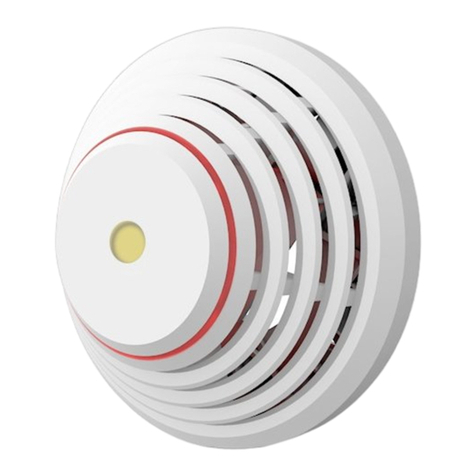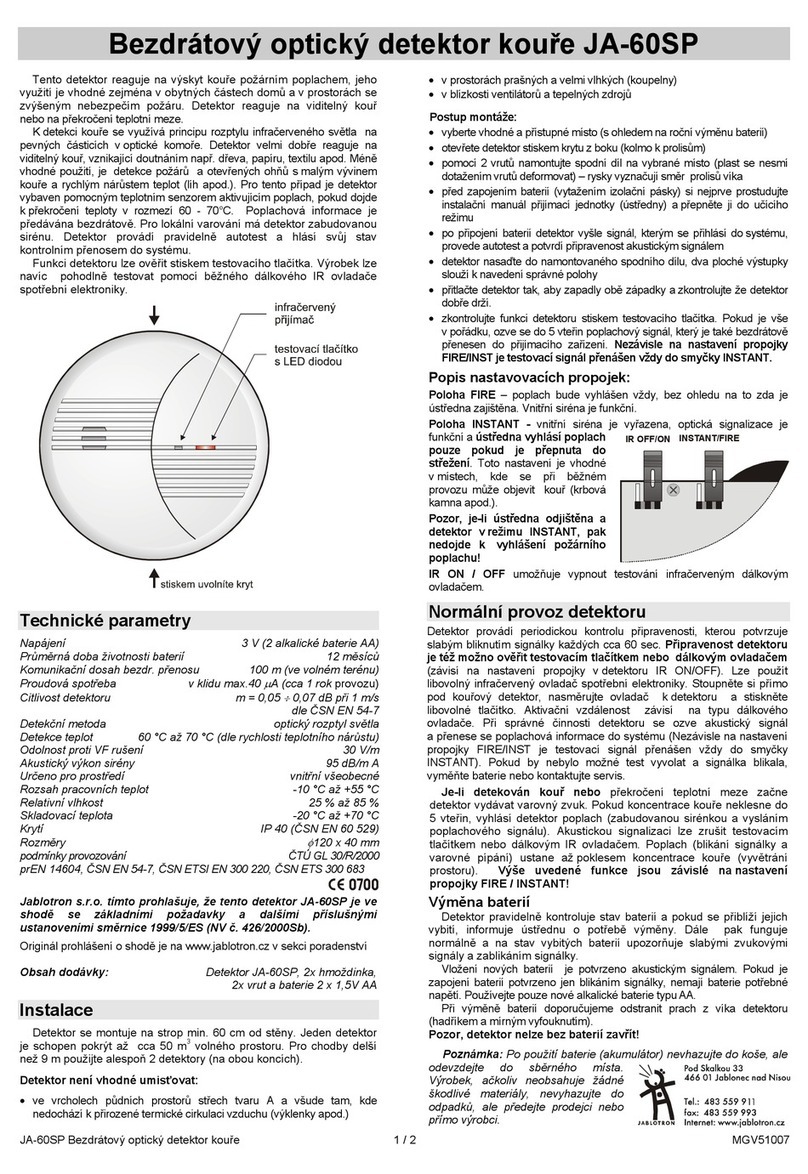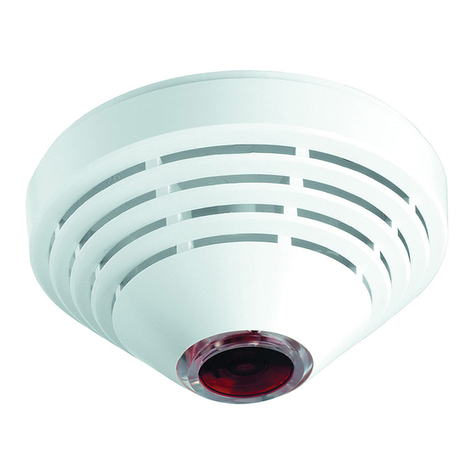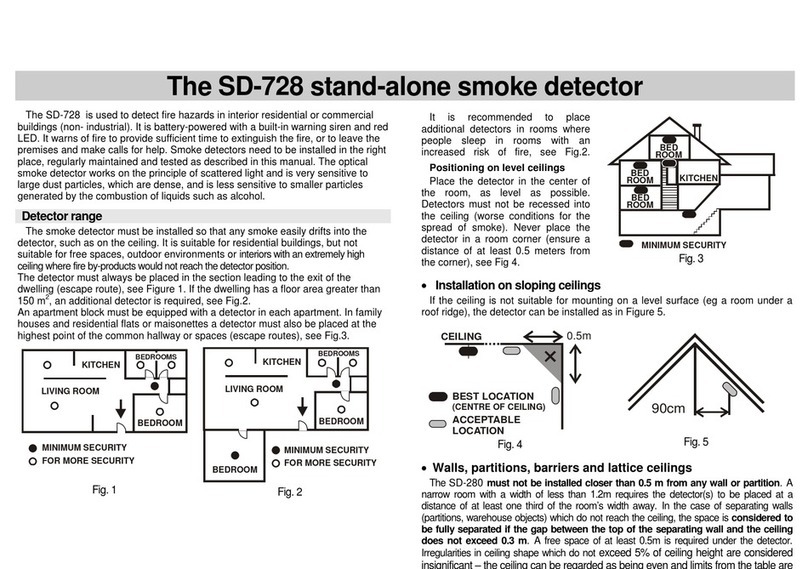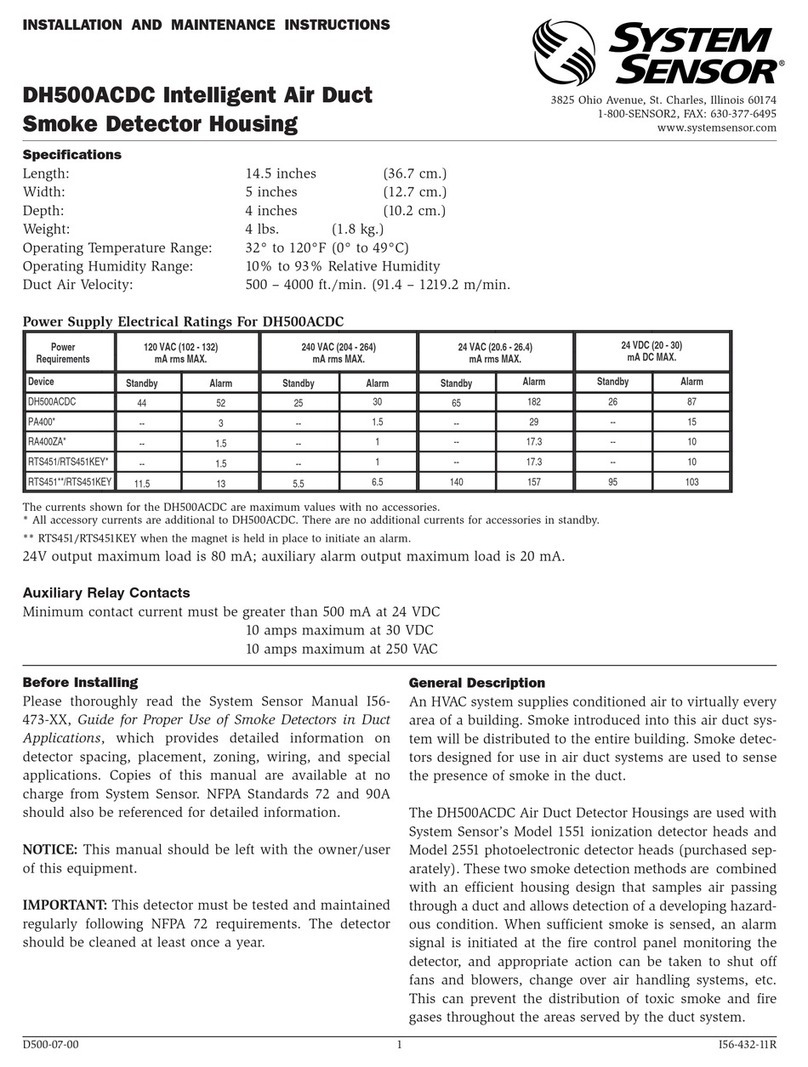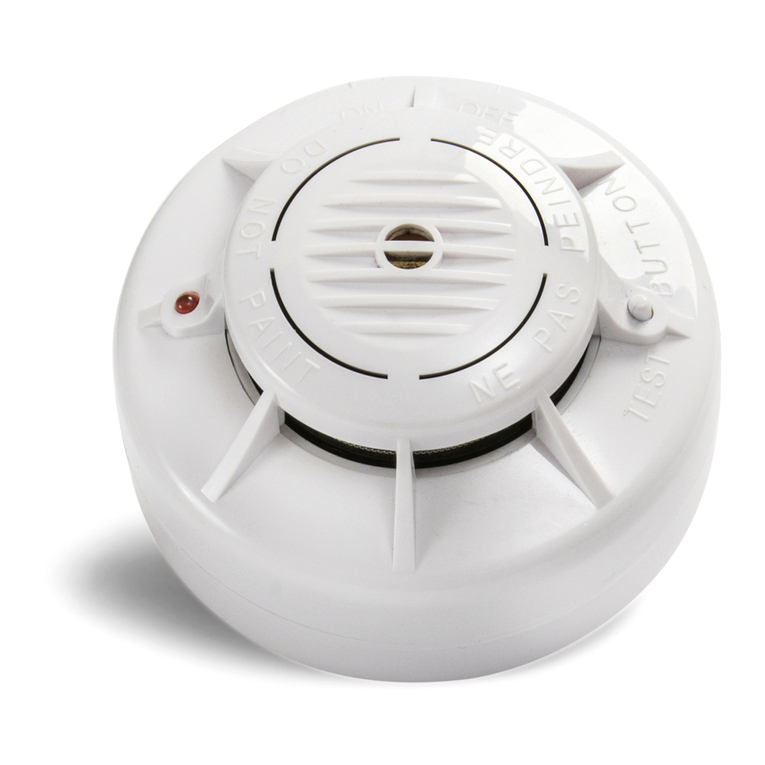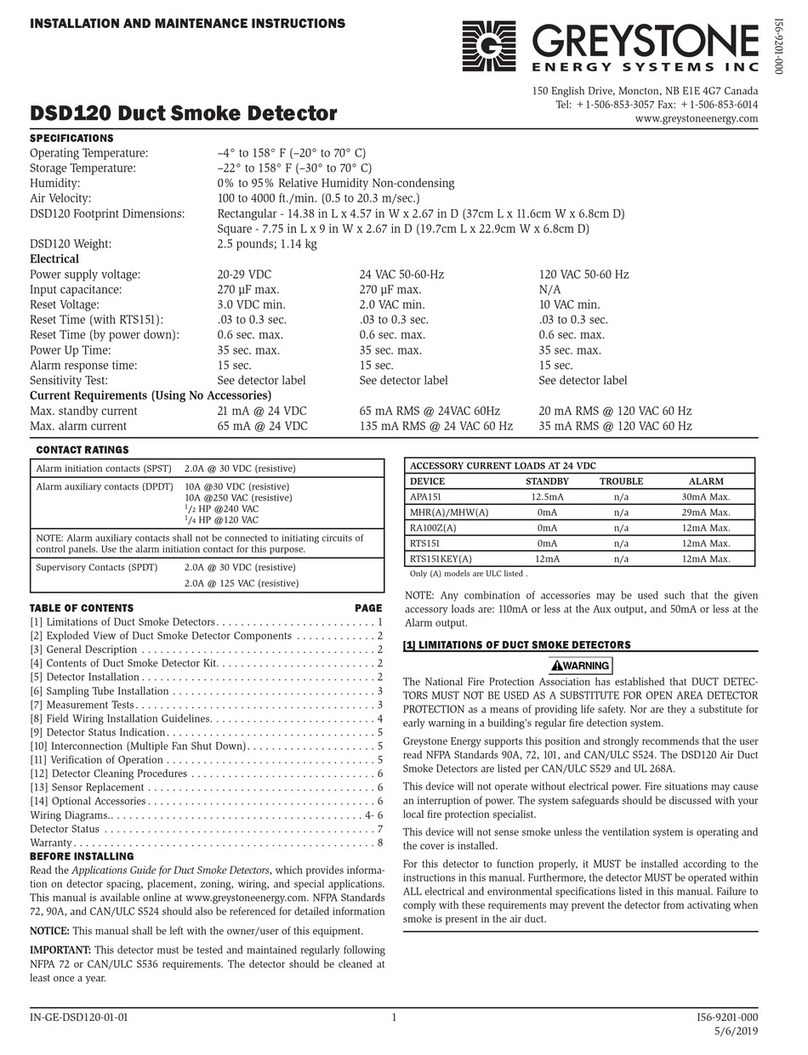
JA-111ST-A BUS combined smoke and heat detector
JA-111ST-A BUS combined smoke and heat detector 2 / 3 MLW21101
b. Click to the option “Scan/add new BUS devices” and select this
detector from the offered list and double-click to confirm
selection. The yellow LED indicator goes off.
6. Insert the detector into the plastic base. The detector can be
inserted in the base in one position only. It is marked with arrows (4)
on both parts of the plastic housing. When inserting the detector,
bear in mind that the connecting wires must not restrain
the functioning of the test buttons.
7. Pre-set the detector functions according to the chapter Detector
settings.
Notes:
We recommend peeling off the sticker with the production code
(6) before you put it onto the mounting base, stick it on a piece
of paper and write down the device location for better
identification of a specific device when enrolling by F-Link
software.
The detector can also be enrolled by inserting into the mounting
base and locking by turning it clockwise when enrollment mode
is open.
The detector can also be enrolled into the system by entering
its production code (6) in the F-Link software (or using a bar
code scanner). All numbers stated under the bar code should
be entered (1400-00-0000-0001).
The detector can be operated without batteries. When there are
no batteries in it, it doesn´t comply with the EN14604 norm.
Before you insert the detector into the mounting base remove
the red blocking tabs from the detector body. The mounting base
must be replaced only by the same bases meant for detector
which is tested by pressing its body (which then works as testing
switch).
If the yellow LED lights permanently, the detector cannot
be enrolled and it indicates a fault with the cabling. We strictly
recommend checking the BUS cables.
Detector setting
The detector properties can be set in the Devices window in
the F-Link software (default settings marked by the symbol *):
The Reaction option in the Devices window allows you to set
the type of system reaction to the activation of the enrolled detector.
To set the detector properties use the internal settings button.
This opens a window where you can set internal settings and
behaviours of the detector.
Reaction: enables the setting whether the detector should react
on smoke only, temperature only, smoke or temperature, smoke and
temperature at the same time; see the following table for details:
Smoke EN 14604, EN 54-7
Temperature EN 54-5
*Smoke or temperature EN 14604, EN 54-5, EN 54-7
Smoke and temperature at once
Thermal class EN54-5 determines the reaction speed of the detector
to temperature increases.
*A1 – A fast reaction to temperature changes. It has to react within 1
min 40 sec when the temperature reaches 30 °C/s.
A2 – A slow reaction to temperature changes. It has to react within 2
min 25 sec when the temperature reaches 30 °C/s. These detector
settings have a high immunity to false alarms in problematical
installations.
Fire alarm acoustic indication:
Source of acoustic indication: Pre-sets the source of the acoustic
indication of a fire alarm signalled by the detector (Switched off, *Own
alarm only, Own and system alarms, System only).
Time limitation of acoustic indication: An option which serves for
time limitation of acoustic indication of a fire alarm by the detector;
optional from 1 to 5 minutes or No limit (*4 min).
Fire alarm indication from sections: Determines from which
sections fire alarms will be indicated.
Other alarm acoustic indication:
Indicate another type of section alarm: Selection of the sections for
which other alarm types and indications will be signalled.
Alarm reaction: Determines when the detector indicates according to
the *IW (Internal warning) or EW (External warning) signal.
Time limitation of acoustic indication: No limit, 1, 2, 3,*4, 5
minutes. When the No limit option is selected, it means the time is taken
from the system parameters. Caution: the maximum alarm length in the
system is 20 minutes.
Muting the system sirens by pressing the detector: This option
allows choosing how to react if the acoustic indication of an alarm from
the system sirens can be terminated by pressing the detector against
the base of the detector. Select from the following options: *Switched
off, during its own alarm, during a system alarm, Switched on.
Batteries: Select the type of batteries used (*alkaline, lithium)
or operating without batteries (the detector doesn´t check the status
of inserted batteries).
Test: By clicking on this button of the detector a self-test (auto test)
is performed. The result is indicated by a green or red dot. Green = test
OK, red = fault – in this case repeat the test and if you get the same
result then the detector should be sent to the service centre.
Fire alarm
Optical detector: When smoke gets into the detecting chamber,
an alarm is triggered and indicated optically by a flashing red LED
(approx. 8x per sec.) and if enabled then also by an acoustic signal
according to the detector settings. Indication takes place until the space
around it or the detecting chamber is ventilated.
Temperature detector: When the temperature increases above
a defined limit an alarm is triggered and indicated optically by a flashing
red LED (approx. 8x per sec.) and if enabled then also by an acoustic
signal according to the detector settings. Indication takes place until
the temperature is decreased by ventilation, for instance.
Silencing the siren during an alarm: The siren can be silenced
by pressing the detector body against the base. The siren is inactive
for 10 minutes. If the detector still detects smoke or heat after this time,
the siren is activated again. When the need arises (e.g. in the case
of a detector failure), it is possible to postpone siren reactivation
by 12 hours. This can be done by pressing the detector again for 5 s
after silencing the siren. When the detector chirps, you have to release
the pressure within 1 s. The switchover to the postponed siren mode
is confirmed with 5 chirps. The detector LED flashes all the time during
the postponement.
Alarm memory: When enabled, LED indication continues flashing
slowly (approx. 2x per sec) for 24 hours after alarm expiration.
Indication is terminated by performing unsetting procedure on already
unset section where the alarm was triggered.
Alarm memory in stand-alone mode indication can be terminated
by pressing the detector body against the wall.
Tamper alarm: When the detector cover is opened, the detector
sends a tamper signal to the control panel. To avoid tamper alarm
triggering enter service mode before opening the detector.
Note:
-When the detector works in stand-alone mode, an alarm is
indicated acoustically and optically with no option to change it.
Other alarms
The detector can indicate other alarms not just alarms triggered by the
detector itself. This includes alarms such as intrusion, tampers, panic,
24 hr and also in relation to IW and EW signals. Settings allow you to
choose specific sections and limits of the alarm length.
Notes:
The indication of other alarms is influenced by system parameters
(i.e. Siren when partially set, Siren IW when tamper triggered,…).
Its own alarm always has a higher priority. When its own alarm
is already being indicated then other alarms are not indicated at all.
A fire alarm has the highest priority. When a tamper alarm, for
instance, is triggered and suddenly a fire alarm is triggered then
indication of tampering is cancelled and it starts with fire alarm
indication immediately.
Detector testing and maintenance
The detector should be tested at least once per month. To test the
detector press the detectors body against the base and wait until a LED
indicator switches on. The LED flashing signals switchover to the testing
mode. The LED flashes for the whole duration of the test. When the test
is complete, the LED switches off. The detector then signals the result.
If the detector beeps once, the test has been done successfully.
If a failure is discovered, the LED flashes and beeps three times.
In this case repeat the test and if you get the same result then
the detector should be sent to the service centre. If the battery is low,
there is no acoustic signalling but just one flash when the test
is completed.
The complete functioning of the optical part of the detector can
be tested with a testing spray (e.g. SD-TESTER). The heat sensor can
be tested with heated air (e.g. with a hair dryer). If the control panel
is not in the SERVICE mode, a fire alarm is triggered.
Warning: never test the detector with fire.
Fault indication
The detector checks its functioning. If it discovers a fault, it chirps and
flashes the LED three times and then flashes briefly three times every
30 s (a fault is signalled the same way when an auto-test is performed,
see the Installation chapter). It could be a faulty detection chamber, an
environmental temperature out of the working range (see Technical
specifications) or some other fault detected in the detector.

